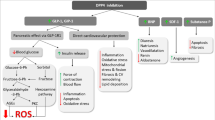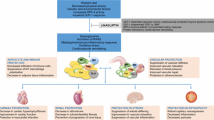Abstract
Atherothrombotic cardiovascular events are a leading cause of morbidity and mortality in patients with type 2 diabetes (T2D). A number of factors beyond hyperglycemia contribute to this increased risk of cardiovascular events in T2D, including elevated blood pressure, dyslipidemia, inflammation, endothelial dysfunction, and enhanced platelet activation. Importantly, most currently available antihyperglycemic treatments for T2D do not address these additional mechanisms. Indeed, we posit that this may explain why more intensive treatment of hyperglycemia has not contributed to a reduced incidence of cardiovascular events in subjects with T2D. Incretin-targeted therapies, such as dipeptidyl peptidase 4 inhibitors, are a relatively new class of antidiabetic treatments, and preclinical as well as small mechanistic clinical studies suggest that they exert beneficial cardiovascular effects. This review focuses specifically on the potential antiatherothrombotic effects of dipeptidyl peptidase 4 inhibitors.
Similar content being viewed by others
References
Papers of particular interest, published recently, have been highlighted as: • Of importance •• Of major importance
Stary HC et al. A definition of initial, fatty streak, and intermediate lesions of atherosclerosis. A report from the Committee on Vascular Lesions of the Council on Arteriosclerosis, American Heart Association. Circulation. 1994;89(5):2462–78.
McNeill AM et al. The metabolic syndrome and 11-year risk of incident cardiovascular disease in the Atherosclerosis Risk in Communities study. Diabetes Care. 2005;28(2):385–90.
Steinberg HO et al. Obesity/insulin resistance is associated with endothelial dysfunction. Implications for the syndrome of insulin resistance. J Clin Invest. 1996;97(11):2601–10.
UK Prospective Diabetes Study (UKPDS) Group. Intensive blood-glucose control with sulphonylureas or insulin compared with conventional treatment and risk of complications in patients with type 2 diabetes (UKPDS 33). Lancet. 1998;352(9131):837–53.
Aronoff S et al. Pioglitazone hydrochloride monotherapy improves glycemic control in the treatment of patients with type 2 diabetes: a 6-month randomized placebo-controlled dose-response study. The Pioglitazone 001 Study Group. Diabetes Care. 2000;23(11):1605–11.
Yousefzadeh P, Wang X. The effects of dipeptidyl peptidase-4 inhibitors on cardiovascular disease risks in type 2 diabetes mellitus. J Diabetes Res. 2013;2013:459821.
Mundil D, Cameron-Vendrig A, Husain M. GLP-1 receptor agonists: a clinical perspective on cardiovascular effects. Diabetes Vasc Dis Res. 2012;9(2):95–108.
Alexander RW. Theodore Cooper Memorial Lecture. Hypertension and the pathogenesis of atherosclerosis. Oxidative stress and the mediation of arterial inflammatory response: a new perspective. Hypertension. 1995;25(2):155–61.
Ferreira L et al. Effects of sitagliptin treatment on dysmetabolism, inflammation, and oxidative stress in an animal model of type 2 diabetes (ZDF rat). Mediat Inflamm. 2010;2010:592760.
Abd El Motteleb DM, Elshazly SM. Renoprotective effect of sitagliptin against hypertensive nephropathy induced by chronic administration of L-NAME in rats: role of GLP-1 and GLP-1 receptor. Eur J Pharmacol. 2013;720(1–3):158–65.
Mistry GC et al. Effect of sitagliptin, a dipeptidyl peptidase-4 inhibitor, on blood pressure in nondiabetic patients with mild to moderate hypertension. J Clin Pharmacol. 2008;48(5):592–8.
Marney A et al. Interactive hemodynamic effects of dipeptidyl peptidase-IV inhibition and angiotensin-converting enzyme inhibition in humans. Hypertension. 2010;56(4):728–33.
Scirica BM, et al. Saxagliptin and cardiovascular outcomes in patients with type 2 diabetes mellitus. N Engl J Med. 2013;369(14):1317–26. This is one of the first long-term safety studies specifically aimed at addressing the cardiovascular outcomes of saxagliptin treatment. The results of this study showed that treatment with saxagliptin was noninferior, but not superior, to placebo for a composite end point of cardiovascular death, MI, and stroke.
Ogawa S et al. Sitagliptin, a dipeptidyl peptidase-4 inhibitor, decreases systolic blood pressure in Japanese hypertensive patients with type 2 diabetes. Tohoku J Exp Med. 2011;223(2):133–5.
Kubota A et al. Pleiotropic effects of sitagliptin in the treatment of type 2 diabetes mellitus patients. J Clin Med Res. 2012;4(5):309–13.
Jagla A, Schrezenmeir J. Postprandial triglycerides and endothelial function. Exp Clin Endocrinol Diabetes. 2001;109(4):S533–47.
Mooradian AD. Dyslipidemia in type 2 diabetes mellitus. Nat Clin Pract Endocrinol Metab. 2009;5(3):150–9.
Matikainen N et al. Vildagliptin therapy reduces postprandial intestinal triglyceride-rich lipoprotein particles in patients with type 2 diabetes. Diabetologia. 2006;49(9):2049–57.
Boschmann M et al. Dipeptidyl-peptidase-IV inhibition augments postprandial lipid mobilization and oxidation in type 2 diabetic patients. J Clin Endocrinol Metab. 2009;94(3):846–52.
Tremblay AJ et al. Effect of sitagliptin therapy on postprandial lipoprotein levels in patients with type 2 diabetes. Diabetes Obes Metab. 2011;13(4):366–73.
Eliasson B et al. Lowering of postprandial lipids in individuals with type 2 diabetes treated with alogliptin and/or pioglitazone: a randomised double-blind placebo-controlled study. Diabetologia. 2012;55(4):915–25.
Plutzky J, Viberti G, Haffner S. Atherosclerosis in type 2 diabetes mellitus and insulin resistance: mechanistic links and therapeutic targets. J Diabetes Complicat. 2002;16(6):401–15.
Libby P, Ridker PM, Maseri A. Inflammation and atherosclerosis. Circulation. 2002;105(9):1135–43.
Alexandraki K et al. Inflammatory process in type 2 diabetes: the role of cytokines. Ann N Y Acad Sci. 2006;1084:89–117.
Sjoholm A, Nystrom T. Inflammation and the etiology of type 2 diabetes. Diabetes Metab Res Rev. 2006;22(1):4–10.
Donath MY, Shoelson SE. Type 2 diabetes as an inflammatory disease. Nat Rev Immunol. 2011;11(2):98–107.
Gorrell MD, Gysbers V, McCaughan GW. CD26: a multifunctional integral membrane and secreted protein of activated lymphocytes. Scand J Immunol. 2001;54(3):249–64.
White PC, Chamberlain-Shea H, de la Morena MT. Sitagliptin treatment of patients with type 2 diabetes does not affect CD4+ T-cell activation. J Diabetes Complicat. 2010;24(3):209–13.
Matsubara J et al. Dipeptidyl peptidase-4 inhibitor, sitagliptin, improves endothelial dysfunction in association with its anti-inflammatory effects in patients with coronary artery disease and uncontrolled diabetes. Circ J. 2013;77(5):1337–44.
Lee SA et al. CD26/DPP4 levels in peripheral blood and T cells in patients with type 2 diabetes mellitus. J Clin Endocrinol Metab. 2013;98(6):2553–61.
Shah Z et al. Long-term dipeptidyl-peptidase 4 inhibition reduces atherosclerosis and inflammation via effects on monocyte recruitment and chemotaxis. Circulation. 2011;124(21):2338–49.
Dobrian AD et al. Dipeptidyl peptidase IV inhibitor sitagliptin reduces local inflammation in adipose tissue and in pancreatic islets of obese mice. Am J Physiol Endocrinol Metab. 2011;300(2):E410–21.
Shirakawa J et al. Diet-induced adipose tissue inflammation and liver steatosis are prevented by DPP-4 inhibition in diabetic mice. Diabetes. 2011;60(4):1246–57.
Vittone F et al. Sitagliptin reduces plaque macrophage content and stabilises arteriosclerotic lesions in Apoe -/- mice. Diabetologia. 2012;55(8):2267–75.
Noyan-Ashraf MH et al. A glucagon-like peptide-1 analog reverses the molecular pathology and cardiac dysfunction of a mouse model of obesity. Circulation. 2013;127(1):74–85.
Dokken BB et al. Oxidative stress-induced insulin resistance in rat skeletal muscle: role of glycogen synthase kinase-3. Am J Physiol Endocrinol Metab. 2008;294(3):E615–21.
Shah Z, et al. Acute DPP-4 inhibition modulates vascular tone through GLP-1 independent pathways. Vasc Pharmacol. 2011;55(1–3):2–9. This is an important study demonstrating the beneficial effect of DPP-4 inhibition in atherosclerotis-prone, high-fat-fed, LDLR -/- mice via reduction of inflammatory recruitment and migration of immune cells.
Mason RP et al. Effect of enhanced glycemic control with saxagliptin on endothelial nitric oxide release and CD40 levels in obese rats. J Atheroscler Thromb. 2011;18(9):774–83.
Liu L et al. Dipeptidyl peptidase 4 inhibitor sitagliptin protects endothelial function in hypertension through a glucagon-like peptide 1-dependent mechanism. Hypertension. 2012;60(3):833–41.
Krijnen PA et al. Loss of DPP4 activity is related to a prothrombogenic status of endothelial cells: implications for the coronary microvasculature of myocardial infarction patients. Basic Res Cardiol. 2012;107(1):233.
Ayaori M et al. Dipeptidyl peptidase-4 inhibitors attenuate endothelial function as evaluated by flow-mediated vasodilatation in type 2 diabetic patients. J Am Heart Assoc. 2013;2(1):e003277.
Vinik AI et al. Platelet dysfunction in type 2 diabetes. Diabetes Care. 2001;24(8):1476–85.
Schneider DJ. Factors contributing to increased platelet reactivity in people with diabetes. Diabetes Care. 2009;32(4):525–7.
Li Y, Woo V, Bose R. Platelet hyperactivity and abnormal Ca2+ homeostasis in diabetes mellitus. Am J Physiol Heart Circ Physiol. 2001;280(4):H1480–9.
Angiolillo DJ et al. Impact of platelet reactivity on cardiovascular outcomes in patients with type 2 diabetes mellitus and coronary artery disease. J Am Coll Cardiol. 2007;50(16):1541–7.
Cameron-Vendrig A, Reheman A, Afroze T, Noyan-Ashraf MH, Ni H, Husain M. Abstract 18777: glucagon-like peptide-1 inhibits thrombin-induced human platelet aggregation. Circulation. 2012;126, A18777.
Gupta AK et al. Sitagliptin: anti-platelet effect in diabetes and healthy volunteers. Platelets. 2012;23(8):565–70.
Gallwitz B, et al. 2-year efficacy and safety of linagliptin compared with glimepiride in patients with type 2 diabetes inadequately controlled on metformin: a randomised, double-blind, non-inferiority trial. Lancet. 2012;380(9840):475–83. The results of this study have been some of the most significant in terms of showing cardiovascular benefits of DPP-4 inhibitor (linagliptin) treatment.
Johansen OE et al. Cardiovascular safety with linagliptin in patients with type 2 diabetes mellitus: a pre-specified, prospective, and adjudicated meta-analysis of a phase 3 programme. Cardiovasc Diabetol. 2012;11:3.
Gitt AK et al. Prognostic implications of DPP-4 inhibitor vs. sulfonylurea use on top of metformin in a real world setting—results of the 1 year follow-up of the prospective DiaRegis registry. Int J Clin Pract. 2013;67(10):1005–14.
Monami M et al. Dipeptidyl peptidase-4 inhibitors and cardiovascular risk: a meta-analysis of randomized clinical trials. Diabetes Obes Metab. 2013;15(2):112–20.
Frederich R et al. A systematic assessment of cardiovascular outcomes in the saxagliptin drug development program for type 2 diabetes. Postgrad Med. 2010;122(3):16–27.
Williams-Herman D et al. Safety and tolerability of sitagliptin in clinical studies: a pooled analysis of data from 10,246 patients with type 2 diabetes. BMC Endocr Disord. 2010;10:7.
Engel SS et al. Cardiovascular safety of sitagliptin in patients with type 2 diabetes mellitus: a pooled analysis. Cardiovasc Diabetol. 2013;12:3.
Scheller NM et al. All-cause mortality and cardiovascular effects associated with the DPPIV-inhibitor sitagliptin compared with metformin, a retrospective cohort study on the Danish population. Diabetes Obes Metab. 2014;16(3):231–6.
White WB et al. Alogliptin after acute coronary syndrome in patients with type 2 diabetes. N Engl J Med. 2013;369(14):1327–35.
Merck Sharp & Dohme. Sitagliptin Cardiovascular Outcome Study (MK-0431-082) (TECOS). National Library of Medicine. 2008–2014. http://clinicaltrials.gov/show/NCT00790205 NLM Identifier: NCT00790205. Accessed 14 Jan 2014.
Boehringer Ingelheim Pharmaceuticals. CAROLINA: Cardiovascular Outcome Study of Linagliptin Versus Glimepiride in Patients with Type 2 Diabetes. National Library of Medicine. 2010–2014. http://clinicaltrials.gov/show/NCT01243424 NLM Identifier: NCT01243424. Accessed 14 Jan 2014.
Oslo University Hospital. Saxagliptin and Atherosclerosis (SAXATH). National Library of Medicine. 2012. http://clinicaltrials.gov/show/NCT01552018 NLM Identifier: NCT01552018. Accessed 14 Jan 2014.
Sheba Medical Center. Effects of Vildagliptin/Metformin Combination on Markers of Atherosclerosis, Thrombosis, and Inflammation in Diabetics with Coronary Artery Disease (VAAST). National Library of Medicine. 2012–2013. http://clinicaltrials.gov/show/NCT01604213 NLM Identifier: NCT01604213. Accessed 14 Jan 2014.
Bristol-Meyers Squibb. Risk of Cardiovascular Events in Patients with Type 2 Diabetes Initiating Oral Antidiabetic Treatments. National Library of Medicine (US). 2010–2012. http://clinicaltrials.gov/show/NCT01086280 NLM Identifier: NCT01086280. Accessed 14 Jan 2014.
Compliance with Ethics Guidelines
Conflict of Interest
Alison Cameron-Vendrig and Mansoor Husain report grants from Merck during the duration of the study. Dhanwantee Mundil declares no conflict of interest.
Human and Animal Rights and Informed Consent
This article does not contain any studies with human or animal subjects performed by any of the authors.
Author information
Authors and Affiliations
Corresponding author
Additional information
This article is part of the Topical Collection on Vascular Biology
Rights and permissions
About this article
Cite this article
Cameron-Vendrig, A., Mundil, D. & Husain, M. Antiatherothrombotic Effects of Dipeptidyl Peptidase Inhibitors. Curr Atheroscler Rep 16, 408 (2014). https://doi.org/10.1007/s11883-014-0408-2
Published:
DOI: https://doi.org/10.1007/s11883-014-0408-2




